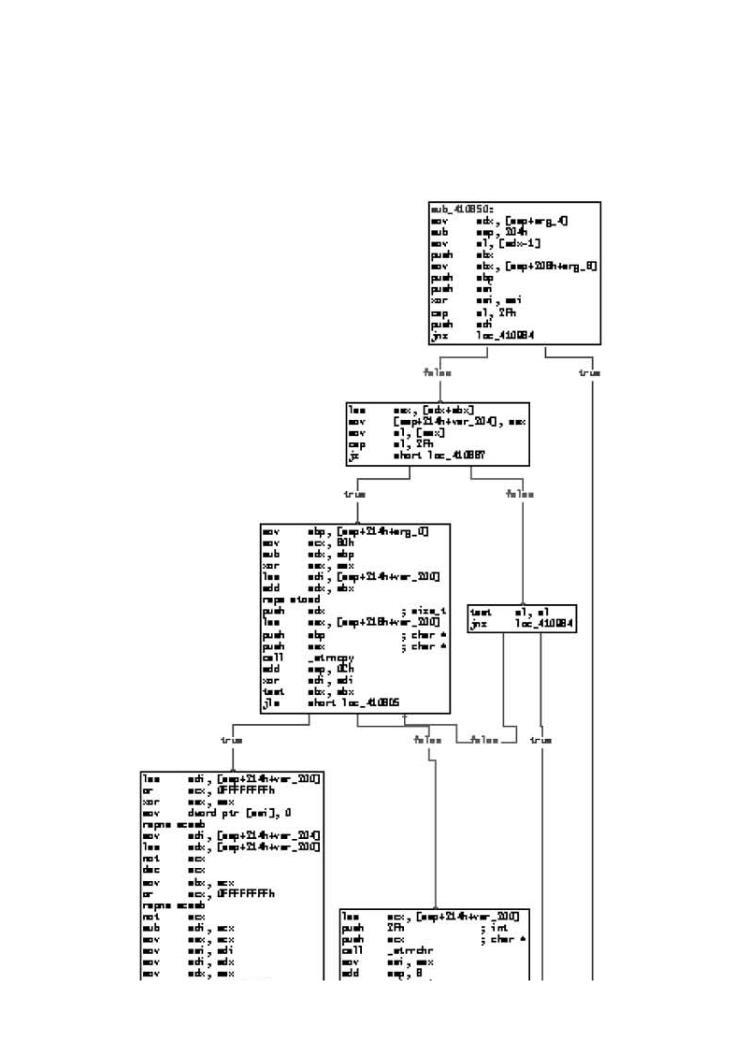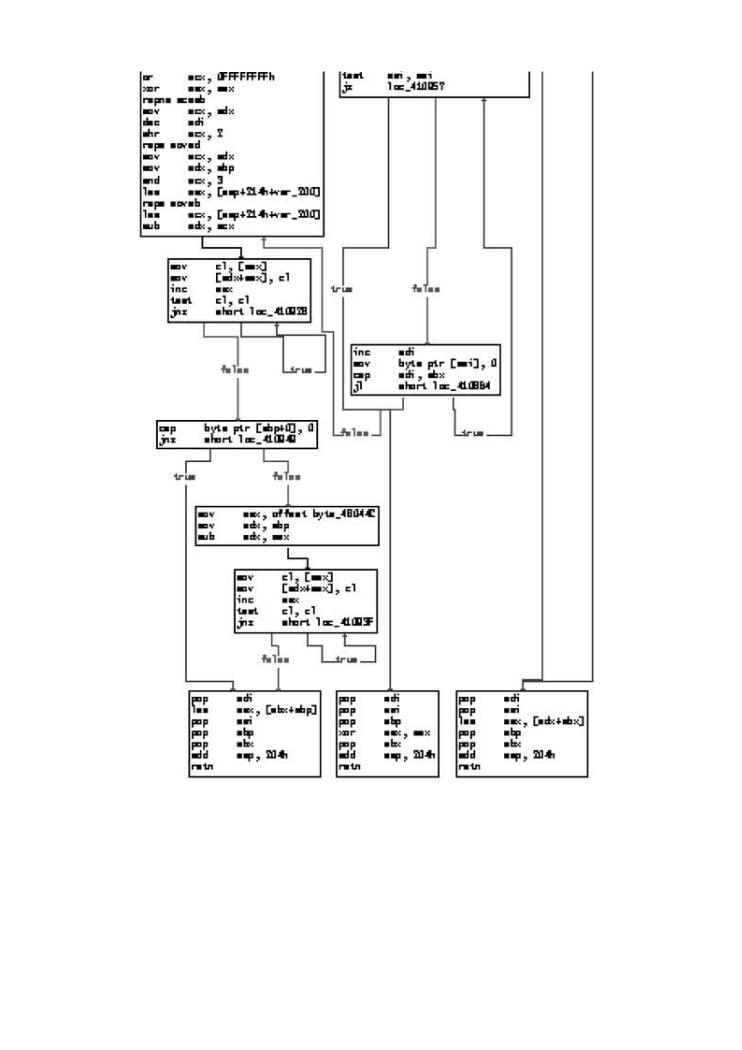
- •Exploiting Software How to Break Code
- •Table of Contents
- •Copyright
- •Praise for Exploiting Software
- •Attack Patterns
- •Foreword
- •Preface
- •What This Book Is About
- •How to Use This Book
- •But Isn't This Too Dangerous?
- •Acknowledgments
- •Greg's Acknowledgments
- •Gary's Acknowledgments
- •Bad Software Is Ubiquitous
- •The Trinity of Trouble
- •The Future of Software
- •What Is Software Security?
- •Conclusion
- •Chapter 2. Attack Patterns
- •A Taxonomy
- •An Open-Systems View
- •Tour of an Exploit
- •Attack Patterns: Blueprints for Disaster
- •An Example Exploit: Microsoft's Broken C++ Compiler
- •Applying Attack Patterns
- •Attack Pattern Boxes
- •Conclusion
- •Into the House of Logic
- •Should Reverse Engineering Be Illegal?
- •Reverse Engineering Tools and Concepts
- •Approaches to Reverse Engineering
- •Methods of the Reverser
- •Writing Interactive Disassembler (IDA) Plugins
- •Decompiling and Disassembling Software
- •Decompilation in Practice: Reversing helpctr.exe
- •Automatic, Bulk Auditing for Vulnerabilities
- •Writing Your Own Cracking Tools
- •Building a Basic Code Coverage Tool
- •Conclusion
- •Chapter 4. Exploiting Server Software
- •The Trusted Input Problem
- •The Privilege Escalation Problem
- •Finding Injection Points
- •Input Path Tracing
- •Exploiting Trust through Configuration
- •Specific Techniques and Attacks for Server Software
- •Conclusion
- •Chapter 5. Exploiting Client Software
- •Client-side Programs as Attack Targets
- •In-band Signals
- •Cross-site Scripting (XSS)
- •Client Scripts and Malicious Code
- •Content-Based Attacks
- •Conclusion
- •Chapter 6. Crafting (Malicious) Input
- •The Defender's Dilemma
- •Intrusion Detection (Not)
- •Partition Analysis
- •Tracing Code
- •Reversing Parser Code
- •Misclassification
- •Audit Poisoning
- •Conclusion
- •Chapter 7. Buffer Overflow
- •Buffer Overflow 101
- •Injection Vectors: Input Rides Again
- •Buffer Overflows and Embedded Systems
- •Database Buffer Overflows
- •Buffer Overflows and Java?!
- •Content-Based Buffer Overflow
- •Audit Truncation and Filters with Buffer Overflow
- •Causing Overflow with Environment Variables
- •The Multiple Operation Problem
- •Finding Potential Buffer Overflows
- •Stack Overflow
- •Arithmetic Errors in Memory Management
- •Format String Vulnerabilities
- •Heap Overflows
- •Buffer Overflows and C++
- •Payloads
- •Payloads on RISC Architectures
- •Multiplatform Payloads
- •Prolog/Epilog Code to Protect Functions
- •Conclusion
- •Chapter 8. Rootkits
- •Subversive Programs
- •A Simple Windows XP Kernel Rootkit
- •Call Hooking
- •Trojan Executable Redirection
- •Hiding Files and Directories
- •Patching Binary Code
- •The Hardware Virus
- •Low-Level Disk Access
- •Adding Network Support to a Driver
- •Interrupts
- •Key Logging
- •Advanced Rootkit Topics
- •Conclusion
- •References
- •Index

Attack Pattern Boxes
Many of the chapters in the remainder of the book include boxes briefly describing particular attack patterns. These boxes serve to generalize and encapsulate an important attack pattern from the text that surrounds it. Such boxes look like this (the example displayed here
• Table of Contents appears in Chapter 4):
•Index
Exploiting Software How to Break Code
ByGreg Hoglund,Gary McGraw
TargetPublisher:ProgramsAddison Wesley That Write to Privileged OS Resources
Pub Date: February 17, 2004
ISBN: 0-201-78695-8
Look for programs that write to the system directories or registry keys (such as HKLM)Pages:. These512 are typically run with elevated privileges and usually have not been designed with security in mind. Such programs are excellent exploit targets because they yield lots of power when they break.
How does software break? How do attackers make software break on purpose? Why are firewalls, intrusion detection systems, and antivirus software not keeping out the bad guys? What tools can be used to break software? This book provides the answers.
Exploiting Softwareis loaded with examples of real attacks, attack patterns, tools, and techniques used by bad guys to break software. If you want to protect your software from attack, you must first learn how real attacks are really carried out.
This must-have book may shock you—and it will certainly educate you.Getting beyond the script kiddie treatment found in many hacking books, you will learn about
 Why software exploit will continue to be a serious problem
Why software exploit will continue to be a serious problem
 When network security mechanisms do not work
When network security mechanisms do not work
 Attack patterns
Attack patterns
 Reverse engineering
Reverse engineering
 Classic attacks against server software
Classic attacks against server software
 Surprising attacks against client software
Surprising attacks against client software
 Techniques for crafting malicious input
Techniques for crafting malicious input
 The technical details of buffer overflows
The technical details of buffer overflows
 Rootkits
Rootkits
Exploiting Softwareis filled with the tools, concepts, and knowledge necessary to break
software.

Conclusion
In this chapter we provided a short introduction to attack patterns and discussed a standard process by which an attack is carried out. Our treatment here is very high level. If you need more information on the basics, check out some of the references we cited. Later chapters
• |
Table of Contents |
dive more deeply into an examination of technical details. Most of the remainder of this book |
|
• |
Index |
is devoted to understanding particular exploits that fit within our attack pattern taxonomy.
Exploiting Software How to Break Code
ByGreg Hoglund,Gary McGraw
Publisher: Addison Wesley
Pub Date: February 17, 2004
ISBN: 0-201-78695-8
Pages: 512
How does software break? How do attackers make software break on purpose? Why are firewalls, intrusion detection systems, and antivirus software not keeping out the bad guys? What tools can be used to break software? This book provides the answers.
Exploiting Softwareis loaded with examples of real attacks, attack patterns, tools, and techniques used by bad guys to break software. If you want to protect your software from attack, you must first learn how real attacks are really carried out.
This must-have book may shock you—and it will certainly educate you.Getting beyond the script kiddie treatment found in many hacking books, you will learn about
 Why software exploit will continue to be a serious problem
Why software exploit will continue to be a serious problem
 When network security mechanisms do not work
When network security mechanisms do not work
 Attack patterns
Attack patterns
 Reverse engineering
Reverse engineering
 Classic attacks against server software
Classic attacks against server software
 Surprising attacks against client software
Surprising attacks against client software
 Techniques for crafting malicious input
Techniques for crafting malicious input
 The technical details of buffer overflows
The technical details of buffer overflows
 Rootkits
Rootkits
Exploiting Softwareis filled with the tools, concepts, and knowledge necessary to break
software.

Chapter 3. Reverse Engineering and
Program Understanding
•Table of Contents
Most• peopleIndinteractx with computer programs at a surface level, entering input and eagerly (impatiently?!)Exploiting SoftwareawaitingHow to Breaka responseCode . The public façade of most programs may be fairly thin,
but most programs go much deeper than they appear at first glance. Programs have a
ByGreg Hoglund,Gary McGraw
preponderance of guts, where the real fun happens. These guts can be very complex.
Exploiting software usually requires some level of understanding of software guts.
Publisher: Addison Wesley
ThePubsingleDate:mostFebruaryimportant17, 2004 skill of a potential attacker is the ability to unravel the complexitiesISBN: 0-of201target-78695-8software. This is called reverse engineering or sometimes just
reversing. Software attackers are great tool users, but exploiting software is not magic and
Pages: 512
there are no magic software exploitation tools. To break a nontrivial target program, an attacker must manipulate the target software in unusual ways. So although an attack almost always involves tools (disassemblers, scripting engines, input generators), these tools tend to be fairly basic. The real smarts remain the attacker's prerogative.
How does software break? How do attackers make software break on purpose? Why are When attacking software, the basic idea is to grok the assumptions made by the people who
firewalls, intrusion detection systems, and antivirus software not keeping out the bad guys? created the system and then undermine those assumptions. (This is precisely why it is critical
What tools can be used to break software? This book provides the answers.
to identify as many assumptions as possible when designing and creating software.) Reverse
engineering is an excellent approach to ferreting out assumptions, especially implicit Exploiting Softwareis loaded with examples of real attacks, attack patterns, tools, and assumptions that can be leveraged in an attack.[1]
techniques used by bad guys to break software. If you want to protect your software from
attack,[1] you must first learn how real attacks are really carried out.
A friend at Microsoft related an anecdote involving a successful attacker who made use of the word "assume" to find interesting places to attack in code. Unsuspecting developers assumed that writing about
This mustwhat -theyaveassumedbook maywouldshockbe OK.youThis—isanda socialit will-levelcertattackinlypatterneducate. Similaryousearches.Gettingthroughbeyondcodethefor
BUG, XXX, FIX, or TODO also tend to work.
script kiddie treatment found in many hacking books, you will learn about
 Why software exploit will continue to be a serious problem
Why software exploit will continue to be a serious problem
 When network security mechanisms do not work
When network security mechanisms do not work
 Attack patterns
Attack patterns
 Reverse engineering
Reverse engineering
 Classic attacks against server software
Classic attacks against server software
 Surprising attacks against client software
Surprising attacks against client software
 Techniques for crafting malicious input
Techniques for crafting malicious input
 The technical details of buffer overflows
The technical details of buffer overflows
 Rootkits
Rootkits
Exploiting Softwareis filled with the tools, concepts, and knowledge necessary to break software.

Into the House of Logic
In some sense, programs wrap themselves around valuable data, making and enforcing rules
about who can get to the data and when. The very edges of the program are exposed to the
•outside worldTablejustoftheContentsway the interior of a house has doors at its public edges. Polite users
go• through theseIndex doors to get to the data they need that is stored inside. These are the entry
pointsExploitingintoSoftwaresoftwareHow. Theto BreakproblemCode is that the very doors used by polite company to access
software are also used by remote attackers.
ByGreg Hoglund,Gary McGraw
Consider, for example, a very common kind of Internet-related software door, the TCP/IP
Publisher: Addison Wesley
port. Although there are many types of doors in a typical program, many attackers first look
Pub Date: February 17, 2004
for TCP/IP ports. Finding TCP/IP ports is simple using a port-scanning tool. Ports provide
public ISBN:access0-201to-software78695-8 programs, but finding the door is only the beginning. A typical
programPages:is complex,512 like a house made up of many rooms. The best treasure is usually found
buried deep in the house. In all but the most trivial of exploits, an attacker must navigate
complicated paths through public doors, journeying deep into the software house. An
unfamiliar house is like a maze to an attacker. Successful navigation through this maze
renders access to data and sometimes complete control over the software program itself.
How does software break? How do attackers make software break on purpose? Why are Software is a set of instructions that determines what a general-purpose computer will do. firewalls, intrusion detection systems, and antivirus software not keeping out the bad guys? Thus, in some sense, a software program is an instantiation of a particular machine (made up What tools can be used to break software? This book provides the answers.
of the computer and its instructions). Machines like this obviously have explicit rules and
well-defined behavior. Although we can watch this behavior unfold as we run a program on a Exploiting Softwareis loaded with examples of real attacks, attack patterns, tools, and
machine, looking at the code and coming to an understanding of the inner workings of a techniques used by bad guys to break software. If you want to protect your software from
program sometimes takes more effort. In some cases the source code for a program is attack, you must first learn how real attacks are really carried out.
available for us to examine; other times, it is not. Therefore, attack techniques must not
always rely on having source code. In fact, some attack techniques are valuable regardless of This must-have book may shock you—and it will certainly educate you.Getting beyond the
the availability of source code. Other techniques can actually reconstruct the source code script kiddie treatment found in many hacking books, you will learn about
from the machine instructions. These techniques are the focus of this chapter.
 Why software exploit will continue to be a serious problem
Why software exploit will continue to be a serious problem
Reverse Engineering
 When network security mechanisms do not work
When network security mechanisms do not work
ReverseAttackengineeringpatterns is the process of creating a blueprint of a machine to discern its rules by
looking only at the machine and its behavior. At a high level, this process involves taking
somethingReversethatengineeringyou may not completely understand technically when you start, and coming
to understand completely its function, its internals, and its construction. A good reverse
Classic attacks against server software
engineer attempts to understand the details of software, which by necessity involves
understanding how the overall computing machinery that the software runs on functions. A
Surprising attacks against client software
reverse engineer requires a deep understanding of both the hardware and the software, and
how it all works together.
 Techniques for crafting malicious input
Techniques for crafting malicious input
Think about how external input is handled by a software program. External "user" input can
 The technical details of buffer overflows
The technical details of buffer overflows
contain commands and data. Each code path in the target involves a number of control
decisions that are made based on input. Sometimes a code path will be wide and will allow
 Rootkits
Rootkits
any number of messages to pass through successfully. Other times a code path will be
narrow, closing things down or even halting if the input isn't formatted exactly the right way. Exploiting Softwareis filled with the tools, concepts, and knowledge necessary to break
This series of twists and turns can be mapped if you have the right tools. Figure 3-1 software.
illustrates code paths as found in a common FTP server program. In this diagram, a complex
subroutine is being mapped. Each location is shown in a box along with the corresponding
machine instructions.
Figure 3-1. This graph illustrates control flow through a subroutine
in a common FTP server. Each block is a set of instructions that runs

as a group, one instruction after the other. The lines between boxes illustrate the ways that control in the code connects boxes. There are various "branches" between the boxes that represent decision points in the control flow. In many cases, a decision regarding how to branch can be influenced by data supplied by an attacker.
• |
Table of Contents |
[View full size image] |
• |
|
|
Exploiting |
|
|
ByGreg |
|
|
Publisher |
|
|
Pub Date |
|
|
ISBN |
|
|
Pages |
|
|
How does |
are |
firewalls, |
guys? |
What tools |
|
Exploiting |
and |
techniques |
from |
attack, |
|
This must |
the |
script kiddie |
|
Why |
|
When |
|
Attack |
|
Classic |
|
 The
The
Exploiting |
break |
software.

•
•
Exploiting
ByGreg
Publisher
Pub Date
ISBN
Pages
How does |
are |
firewalls, |
guys? |
What tools |
|
Exploiting |
and |
techniques |
from |
attack, |
|
This must |
the |
script kiddie |
|
Why |
|
When |
|
Attack |
|
Classic |
|
 The
The
 Rootkits
Rootkits
Generally speaking, the deeper you go as you wander into a program, the longer the code
Exploiting Softwareis filled with the tools, concepts, and knowledge necessary to break path between the input where you "start" and the place where you end up. Getting to a
software.
particular location in this house of logic requires following paths to various rooms (hopefully where the valuables are). Each internal door you pass through imposes rules on the kinds of messages that may pass. Wandering from room to room thus involves negotiating multiple sets of rules regarding the input that will be accepted. This makes crafting an input stream that can pass through lots of doors (both external and internal) a real challenge. In general, attack input becomes progressively more refined and specific as it digs deeper into a target program. This is precisely why attacking software requires much more than a simple bruteforce approach. Simply blasting a program with random input almost never traverses all the code paths. Thus, many possible paths through the house remain unexplored (and

unexploited) by both attackers and defenders.
Why Reverse Engineer?
Reverse engineering allows you to learn about a program's structure and its logic. Reverse engineering thus leads to critical insights regarding how a program functions. This kind of
• |
Table of Contents |
insight is extremely useful when you exploit software. There are obvious advantages to be |
|
• |
Index |
had from reverse engineering. For example, you can learn the kind of system functions a
Exploiting Software How to Break Code
target program is using. You can learn the files the target program accesses. You can learn theByGregprotocolsHoglund,theGarytargetMcGrawsoftware uses and how it communicates with other parts of the target network.
Publisher: Addison Wesley
The most powerful advantage to reversing is that you can change a program's structure and
Pub Date: February 17, 2004
thus directly affect its logical flow. Technically this activity is called patching, because it
ISBN: 0-201-78695-8
involves placing new code patches (in a seamless manner) over the original code, much like a patch Pages:stitched512on a blanket. Patching allows you to add commands or change the way particular function calls work. This enables you to add secret features, remove or disable functions, and fix security bugs without source code. A common use of patching in the computer underground involves removing copy protection mechanisms.
Like any skill, reverse engineering can be used for good and for bad ends.
How does software break? How do attackers make software break on purpose? Why are firewalls, intrusion detection systems, and antivirus software not keeping out the bad guys? What tools can be used to break software? This book provides the answers.
Exploiting Softwareis loaded with examples of real attacks, attack patterns, tools, and techniques used by bad guys to break software. If you want to protect your software from attack, you must first learn how real attacks are really carried out.
This must-have book may shock you—and it will certainly educate you.Getting beyond the script kiddie treatment found in many hacking books, you will learn about
 Why software exploit will continue to be a serious problem
Why software exploit will continue to be a serious problem
 When network security mechanisms do not work
When network security mechanisms do not work
 Attack patterns
Attack patterns
 Reverse engineering
Reverse engineering
 Classic attacks against server software
Classic attacks against server software
 Surprising attacks against client software
Surprising attacks against client software
 Techniques for crafting malicious input
Techniques for crafting malicious input
 The technical details of buffer overflows
The technical details of buffer overflows
 Rootkits
Rootkits
Exploiting Softwareis filled with the tools, concepts, and knowledge necessary to break
software.
